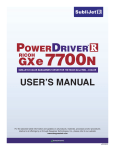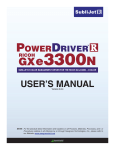Download 3M Scotch-Weld PUR Appl Install Guide
Transcript
3 Scotch-Weld™ Polyurethane Reactive Adhesive Applicator Replacement Part Installation Guide Description: HEAT TUBE KIT Product ID/Stock No.: 62-9895-0023-6 For use with: 3M™ Scotch-Weld™ Polyurethane Reactive Adhesive Applicator Serial Nos. US 00100 and above Important Safety Instructions ! WARNING ! WARNING Do not clean or remove 3M™ Scotch-Weld™ Adhesive with heat, flame, or solvent. These acts may cause hazardous vapors or fire. For additional health and safety information, see product label and Material Safety Data Sheet for Scotch-Weld Adhesive used. Disconnect air and electrical power and make sure applicator has cooled to room temperature below servicing. Failure to follow these precautions may cause electrical shock or burns. ! WARNING IMPORTANT Do not attempt to disassemble this replacement heattube. There are no user serviceable parts. Proper factory assembly is necessary for required temperature control. Any attempt to alter this assembly may cause hazardous conditions. The service procedure shown in this installation guide should be performed only by qualified electrician or service person. ! WARNING Avoid contact with the insulation wrap surrounding the heattube. Avoid any acts that would generate dust particles. The ceramic fiber material may be harmful if inhaled. May cause skin, eye and respiratory tract irritation. Refer to 3M™ Scotch-Weld™ Polyurethane Reactive Adhesive Applicator User’s Manual for more information. Read the manual completely before servicing the applicator. Installation Guide A B 1. 2. Disconnect air and electrical power and allow the applicator to cool to room temperature before disassembly. Cut and discard the plastic tie wrap located closest to the applicator that holds power cord and air hose together. Unscrew the endcap from the heattube and remove adhesive cartridge and main nozzle, if installed. Pull one side of the wirestand out of the pivot hole (A) and allow it to spring down into the recessed area (B). NOTE: Do not attempt to pull the end completely out in this step or binding may occur on the other side. For best results, follow steps 2 and 3 to reduce possible damage to wirestand or applicator. NOTE: If the endcap cannot be unscrewed, disassembly may not be possible. Contact your Scotch-Weld distributor for assistance. If a cartridge cannot be removed, a new main nozzle assembly, 62-98950019-4 will be required for operation. -1- 3. 5. Turn the applicator over and pull the other side of the wirestand out of the other pivot hole and over the edge of the applicator. The wirestand can now be removed completely. Save the wirestand for reassembly. 4. To make sure the upper housing will lift off cleanly, just slightly separate the two halves at the location shown. Clear an area to the left of the applicator to allow both housings to lie side by side. 6. Remove the 12 screws that hold the housing halves together and save them for reassembly. NOTE: A long, magnetized Phillips bit (P2) is recommended because it will pull screws out of the deeper recesses. If a non-magnetized bit is used, it may be necessary to hold the housing halves together and turn the applicator over to allow the screws to drop out. It is recommended that all the screws be removed before separating housings. This ensures that a partially loosened screw will not cause problems in steps 5 and 6. Hold the trigger and the air hose up into the upper housing and lift off – at the same time flipping it over so the interior is visible – and lay it next to the lower housing. NOTE: If adhesive contamination prevents separation of the housings, contact your Scotch-Weld distributor for assistance. Do not attempt to remove Scotch-Weld adhesives with heat, flame, or solvent. This may cause hazardous vapors or fire. HINT: To prevent the weight of the power cord and air hose from pulling the applicator off the work surface, they can be taped, tied, or put in a drawer just beneath the work surface, if available. HINT: Position the endcap above the rear portion of the applicator as shown so it will not interfere when laying the upper housing down. -2- C 7. D C 8. Remove the upper front standoff (C) and rear standoff (D) and set aside for reassembly. The standoffs might be found either on the heat tube or in the upper housing. Loosen the three terminal block screws indicated by arrows about 3-4 turns. Either a 1/8 in. slotted blade screwdriver or a Phillips (P1) screwdriver can be used. NOTE: If the standoffs are difficult to remove from the heattube, pliers can be used to pull them off. The standoff material is soft, so care must be used when using pliers to reduce possibility of damage. If the standoffs remain in place in the upper housing, remove them only if they are loosely held and would fall out of place during reassembly. E F 9. Grasp the faulty heat tube by the metal ends and lift it out of the lower housing. Avoid handling the insulation wrap – see below. 10. NOTE: If the standoffs in the lower housing come out of with the heat tube or are dislodged in any way, replace them into position in the lower housing, making sure that each one is fully seated. Note that the rear standoff is larger than the front standoff. ! WARNING Avoid contact with the insulation wrap surrounding the heat tube. Avoid any acts that would generate dust particles. The ceramic fiber material may be harmful if inhaled. May cause skin, eye, and respiratory tract irritation. -3- Hold the replacement heattube by the metal ends, aligning the keys (E) with the recesses (F) in the standoffs and push down into place. If necessary, rotate the heat tube slightly, to make sure the heattube is fully seated into the standoffs. B R Y G 11. A 12. Route the wire leads as shown. Hold wires gently with a needle-nosed pliers to obtain bends. If necessary, twist the end connectors (A) so the wide sides are horizontal. Using needle-nosed pliers to hold wires, insert each about 1/4 in. (6.4 mm) into proper hole in terminal blocks and tighten screws firmly. Make sure the red (R), yellow (Y), and green (G) wires match up with wires of similar color on the other side of the terminal blocks. Check for proper electrical installation by connecting a multimeter or continually tester across the power cord plug blades. Continuity should exist when the switch is pushed to the on position. If continuity is not obtained, check wires to make sure they are firmly fastened into terminal blocks. If problem persists, see owner’s manual for applicator and repeat troubleshooting procedures. IMPORTANT: Make sure the wire leads are side by side inthe circled area (B) and are not on top of one another. If the wires are not side by side, interference with the air valve could occur during reassembly. D F E C 13. 14. Place upper standoffs into grooves in heattube, making sure keys in heat tube are fully engaged in recesses in standoffs. Upper and lower sets of standoffs should be in contact with no visible gaps between them at all four locations (C). Note that the rear standoff is larger than the front standoff. On the upper housing, make sure the trigger (D) is engaged on the valve button (E) and the trigger is positioned properly in its bearing. Push the valve (F) down so it is positioned as shown and make sure the air tubes are held in the grooved rib as illustrated. This will help to keep the valve in position when the housing is inverted in step 16. When properly positioned, the top flat of the hexagonal valve body will be horizontal and the tube fittings will be directed away from you and down along the inside surface of the housing. -4- A1 E1 A2 A3 E2 A4 E3 15. Check the locations indicated by arrows above to make sure all components are positioned properly. Wires at E1 and E2 should be down into positions so the upper housing and air valve will not pinch them during reassembly. Air tubing at A1, A2 and A3 should be positioned in grooved ribs so valve will be held in position. The power cord strain relief at E3 needs to be in approximate position – final adjustment can be made in step 17 – along with readjustment of air hose at A4. 16. Hold trigger and the air hose in position in the upper housing and lift and turn the upper housing over onto the lower housing. Crossing the hands as shown will make it easier to hold the components in position while turning the housing over. Make sure both housings are aligned and press them together. Attach one housing screw along the top of the applicator where shown, but do not fully tighten. This will hold the housing halves together during final adjustment of power cord and air hose. NOTE: You should feel a definite engagement when the housing halves mate properly. If not, lift the upper housing off – as in step 6 – and check for components that might be out of position. Repeat steps 15 and 16. H 17. Separate the housing halves at the bottom of the handle just enough to adjust the position of the power cord strain relief. The hex (H) should be aligned and fully engaged with the matching hex-shaped recess in the housings. If necessary, rotate the strain relief hex one flat in either direction to obtain good fit. If necessary, adjust the position of the air supply hose so it is located properly in the circular recesses. While holding the housings halves together, insert a housing screw into the lowest hole and tighten just snugly. 18. Recheck proper fit and alignment between the housing halves and make sure the trigger pivots freely. Insert the other 10 housing screws and tighten all the screws firmly but not too tightly. IMPORTANT: Do not use a large screwdriver or a powerdriver at a high torque setting. Overtightening the housing screws could cause the threads to strip out and damage the lower housing. -5- A B C 19. Hold the wirestand so the rounded part (C) curves away from the applicator and temporarily hook one end of the wirestand so the end rests down in the bottom of the recess (B) as shown. 21. Pull the first end of the wirestand – from step 19 – out of the recess and position it over its pivot hole. The spring action of the wirestand will pull itself down into place. If desired, the plastic tie wrap provided can be used to hold the power cord and the air supply hose together near the bottom of the applicator handle. Make sure you trim the excess carefully so there are no sharp edges. 20. -6- Pull the other end of the wirestand just enough to go over the edge of the applicator and position it into the pivot hole (A). The spring action of the wirestand will pull itself down into place. LIMITED WARRANTY: 3M warrants for a period of 30 days from the date of purchase or use, whichever occurs first, that the 3M™ Scotch-Weld™ Heat Tube Kit will be free of defects in material and manufacture. 3M MAKES NO OTHER WARRANTIES, EXPRESS OR IMPLIED, WITH RESPECT TO THE SCOTCH-WELD HEAT TUBE KIT INCLUDING, BUT NOT LIMITED TO, ANY IMPLIED WARRANTY OF MERCHANTABILITY OR FITNESS FOR A PARTICULAR PURPOSE. This limited warranty does not cover damage resulting from accident, misuse or abuse, lack of reasonable care, service performed by an unauthorized repair service, use of unauthorized replacement parts, operation or maintenance not in accordance with 3M recommended procedures, or the use of adhesive cartridges not manufactured by 3M or not subject to 3M finished product standards. LIMITATION OF REMEDIES: If the Scotch-Weld Heat Tube Kit is proved to be defective within the warranty period stated above. THE EXCLUSIVE REMEDY AND SOLE OBLIGATION OF 3M SHALL BE, AT 3M’S OPTION, THE REFUND OF THE PURCHASE PRICE, REPAIR OR REPLACEMENT OF THE DEFECTIVE SCOTCH-WELD HEAT TUBE KIT. LIMITATION OF LIABILITY: Except for the exclusive remedy stated above, 3M shall not otherwise be liable for any loss or damages, whether direct, indirect, special, incidental, or consequential, regardless of the legal theory asserted, including negligence, warranty, or strict liability. 3 Industrial Business Industrial Adhesives and Tapes Division 3M Center, Building 220-5E-06 St. Paul, MN 55144-1000 Recycled Paper 40% pre-consumer 10% post-consumer Printed in U.S.A. ©3M 2005 78-6900-7027-7 (1/05)

















